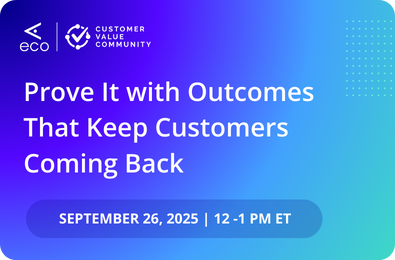Why do we pay $2.50 for the same cup of coffee we can get for 79 cents?
The answer comes in understanding customer perceived value. Starbucks has changed our perceived value of coffee. We are not simply buying coffee at Starbucks–we are buying an “experience.” This experience offers an expanded set of value drivers such as a variety of flavors and tastes, store ambiance, customer service, and physical connection in an increasingly impersonal, technology-dominated world. We pay more because we perceive a greater value. In business-to-business selling, many sales professionals unconsciously commoditize their value proposition by presenting value in limiting formats like Return on Investment (ROI), Total Cost of Ownership (TCO), Internal Rate of Return (IRR), and Payback Period. These formats are encouraged by prospective buyers seeking standardization in order to compare potential investments internally. Each project is reduced to hard measures with the common refrain, “just show me the hard cost saving.”More Than ROI: Strategic Value BenefitsWhile these metrics are important and necessary, they don’t capture the total value around a potential project–thus minimizing the perceived value. There are projects which may never be funded because they have no cost-reduction element, yet have significant strategic value to enhance customer loyalty, create new business opportunities, or increase employee productivity. The perception is that these project value drivers are difficult to quantify and thus get marginalized as “soft benefits.” As a result, sometimes the most significant, strategic value benefits of a purchase are never even mentioned in the justification discussions about the project. The result? A watered-down value message which translates into predictable outcomes such as no decision, delay, or heavy price discounting by the seller. When the only value driver around a cup of coffee is the ingredients, $2.50 for a cup will never be justified in any family boardroom.
What’s the Solution? Meet the VMO.
Some sales and marketing organizations now deploy a more comprehensive approach to increasing customer perceived value, through a Value Management Office (VMO) for their customers. A VMO helps end-customers quantify and track the total value around a proposed project. The VMO goes beyond traditional accounting measures of value to help end-customers unlock full value–especially in areas that were historically difficult to measure.
A group of value experts in the VMO share best practice templates to help end-customers measure all aspects of project value. This expanded view shows how a project can accelerate stated company initiatives around agility, contribute to sustainability and customer loyalty goals, streamline work processes, align to individual job performance metrics, and even impact the personal value drivers of key decision makers like status, reputation, and organizational credibility. The VMO captures company impact, work impact, and personal impact associated with a given project. But does this VMO really work or does it just complicate and elongate the sales cycle?
A Real Use Case
In a recent case, an account team’s end-customer was having problems with high abandonment rates at its stores. The account team was offering a solution to increase the efficiency of the stores and reduce the abandonment rate. A $200,000 deal was placed on the desk of the CIO for review. Before he signed, he wanted the answer to his question: “How will this increase our stores’ existing processes?” The sales team took a step back. With the help of the VMO, they took time to fully understand the customer’s challenges and look at the benefits of the solution–from the customer’s perspective. With a narrow focus on value, the solution was only worth the small price. Once the whole value of the solution was revealed, the CIO saw the high impact it would have on his organization–and the deal grew in size by 300%. He signed off on the proposal in under two weeks. By revealing the entire picture of value, the customer saw all of the areas of value that the solution would provide, not just the narrow ROI analysis. What pieces of value are you missing in conversations with your customer? Stay tuned for the next Voice of Value post, where I’ll discuss another piece to the puzzle of revealing full value. In the meantime, I’ll be drinking my $2.50 cup of coffee.
About the Author
Chad Quinn
Chad is the president and founder of Ecosystems. For the last 15 years, Chad has led the organization, focusing on helping Fortune 500 companies set up Value Management Offices (VMOs) to quantify, capture, and report on business value. Chad’s passion is to impact the lives of others. At Ecosystems, he focuses on clarifying the impact of investments on business strategy and operations. Within his community, he focuses on the impact of local organizations while serving as the Chair of the McLean Community Center Governing Board.
























